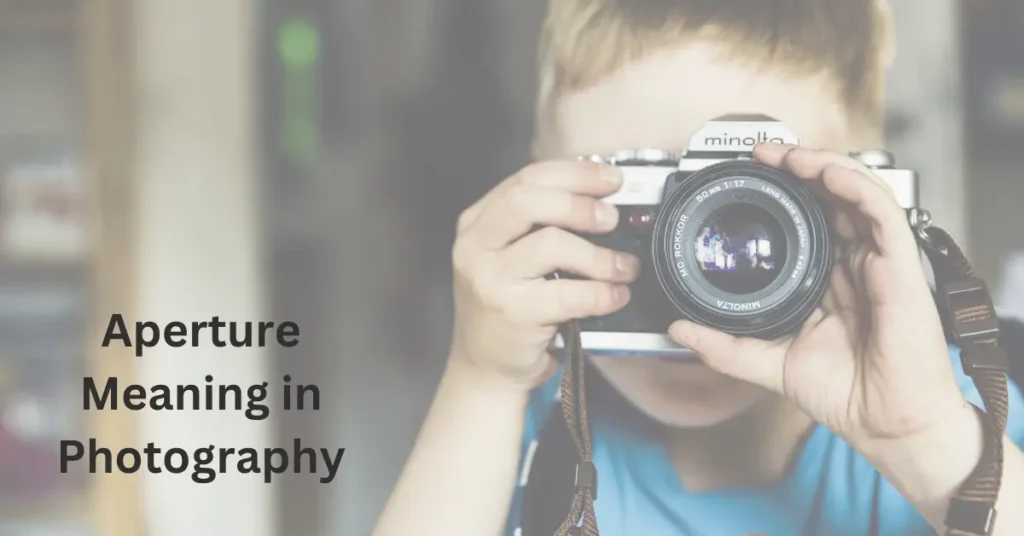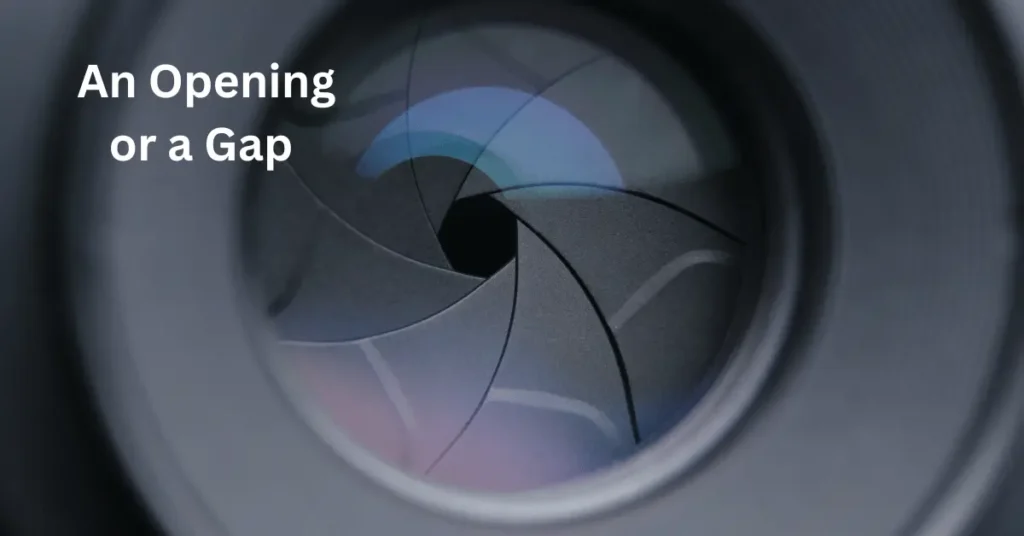Aperture Meaning in Photography

Have you ever wondered what the word aperture meaning in photography? Whether you’re a photography enthusiast or just curious about everyday terms, understanding “aperture meaning” can be surprisingly interesting!
In simple terms, aperture refers to an opening or an open space, and it’s a concept that pops up in various fields, from photography to physics.
In this article, we’ll dive into what aperture means, especially in photography, and how it can help you take better photos or simply understand the world around you a bit more clearly.
So, let’s break it down in a fun and easy way!
What Does Aperture Mean?
At its core, the word aperture simply refers to an opening or a gap. It’s the space through which something—like light, air, or sound—can pass. In general use, when you hear the word aperture, think of it as a hole or opening in a physical object that allows passage.
For example, the aperture of a door is the space where the door opens, or the aperture of a window is the space that lets light come through.
When we talk about aperture in photography, the meaning becomes a bit more specific. In the context of cameras, aperture refers to the opening inside a lens that controls how much light enters the camera.
This opening is adjustable, and by changing its size, you can control the amount of light that reaches the camera’s sensor or film.
Aperture is one of the key elements that influence the exposure of your photos, along with shutter speed and ISO.
Aperture is measured in f-stops, like f/1.4, f/5.6, or f/16. The f-stop number indicates how large or small the aperture opening is.
A smaller f-number (like f/1.4) means a larger opening, which lets in more light. On the other hand, a larger f-number (like f/16) means a smaller opening, letting in less light.
But aperture doesn’t just affect the exposure of your photo—it also has a big impact on something called “depth of field.” Depth of field refers to how much of your photo is in focus from front to back.
A wide aperture (small f-number) creates a shallow depth of field, where only the subject is sharp and the background is blurry.
A smaller aperture (larger f-number) gives you a deeper depth of field, where more of the scene, from the foreground to the background, appears in focus.
So, in summary, aperture in photography is the opening in a camera lens that controls the amount of light entering the camera, which affects both the exposure and the focus of your photo.
It’s a powerful tool for shaping how your images turn out!
Definition of Aperture
Aperture refers to an opening or an open space that allows light, air, or other substances to pass through.
In various fields, it is used to describe any gap, hole, or space that provides a way for something to enter or exit.
The term is commonly associated with optics, photography, and even architecture, but its basic meaning remains the same—an opening or a space through which something can pass.
Aperture Meaning in Photography
In the context of photography, aperture specifically refers to the adjustable opening within a camera lens that controls the amount of light that enters the camera.
This opening plays a crucial role in exposure, helping determine how bright or dark a photo will be.
Aperture is measured using f-stop numbers, with smaller numbers (like f/1.4) indicating a larger opening, and larger numbers (like f/16) representing smaller openings.
Examples of Aperture Meaning
In Photography
If you are photographing a portrait and want a blurred background, you might choose a wide aperture, such as f/2.8.
This creates a large opening in the lens, letting in a lot of light and resulting in a shallow depth of field, where only the subject is in focus and the background is blurred.
For a landscape photo, you might choose a narrow aperture, such as f/16, which reduces the amount of light entering the camera and increases the depth of field, making more of the scene appear in focus from front to back.
In Everyday Life
Think of a window in your house. The aperture of the window is the space where the glass is, allowing light to enter your room.
The bigger the window, the larger the aperture, and the more light can pass through.
Another example is a door.
When you open a door slightly, you create a small aperture. If you open the door wide, you create a larger aperture, allowing more people to pass through at once.
In Other Fields
Optics and Physics: An aperture in a telescope or microscope refers to the opening that allows light to enter and be focused by the lens.
In telescopes, a large aperture allows more light to gather, which is important for viewing distant stars or planets.
Architecture: In architecture, an aperture might refer to a window or opening in a building’s wall, which is specifically designed to let light or air enter.
Aperture is simply an opening that allows something—whether it’s light, air, or people—to pass through.
In photography, it’s the adjustable space in the camera lens that controls how much light gets into the camera and influences both the exposure and focus of the image.
Understanding aperture helps photographers control their shots and create the effects they desire, from bright, well-lit photos to dramatic, blurred backgrounds.
Word Origin of “Aperture”

The word “aperture” comes from the Latin verb “aperire”, which means “to open” or “to uncover.”
The Latin root “aperire” is derived from the combination of “a-” (a variant of “ab-” meaning “away from”) and “aperire,” which conveys the idea of “opening up” or “making something accessible.”
Essentially, the word aperture conveys the action of “opening” or “allowing entry.”
The term first appeared in English in the 15th century, maintaining this sense of an opening or gap.
It was originally used to describe any type of opening or hole, whether it be in an object, structure, or natural formation.
Over time, the word evolved and began to be applied more specifically to different technical fields such as optics, photography, and architecture.
In optics and photography, the word took on a more specialized meaning, referring to the adjustable opening in a lens or device that controls the flow of light.
This usage became particularly relevant in the 19th century as photography developed. Early cameras featured simple openings (apertures) that could be adjusted manually to control how much light entered the camera to expose the film or photographic plates.
As technology advanced, the term aperture became more closely associated with the settings on cameras and other optical devices, and it remains a key concept in modern photography today.
The word “aperture” originates from the Latin verb “aperire,” meaning “to open.”
Its usage has expanded over the centuries to include a range of meanings, from a general opening to its more specialized application in fields like photography and optics.
The evolution of the term reflects its broad relevance in both everyday language and technical contexts, where it continues to describe the spaces that allow things—especially light—to pass through.
FAQs
What is aperture in photography?
Aperture in photography refers to the opening in a camera lens through which light passes to reach the camera’s sensor or film. The size of this opening determines how much light enters the camera, affecting the exposure of the image. Aperture is measured in f-stops (e.g., f/1.4, f/2.8, f/16), with smaller f-stop numbers indicating a larger opening and more light entering, while higher numbers represent a smaller opening and less light.
How does aperture affect the depth of field?
Aperture has a significant impact on depth of field, which refers to how much of the image appears in focus. A wide aperture (small f-number, like f/1.8) creates a shallow depth of field, meaning only the subject will be sharp, and the background will be blurred. On the other hand, a narrow aperture (large f-number, like f/16) creates a deeper depth of field, where both the foreground and background are more likely to be in focus.
What is the best aperture for portraits?
For portrait photography, a wide aperture (such as f/1.4, f/1.8, or f/2.8) is often preferred. A wide aperture allows more light into the camera and produces a shallow depth of field, which helps to blur the background and make the subject stand out sharply against a smooth, creamy background (known as bokeh). This effect adds a professional touch to portrait shots.
Does a larger aperture always mean better photos?
Not necessarily. While a larger aperture allows more light to enter the camera, which can be beneficial in low-light situations, it also creates a shallower depth of field, which may not always be desired. The best aperture to use depends on your subject and the effect you want to achieve. For instance, for landscape photography, you might prefer a smaller aperture (larger f-number) to keep both the foreground and background in focus.
How do I choose the right aperture for my shot?
Choosing the right aperture depends on your creative goals and lighting conditions. If you want a blurry background (for portraits or macro shots), go for a wide aperture (low f-number). If you need everything in focus (like in landscape photography), opt for a smaller aperture (high f-number). Additionally, consider the lighting: in brighter conditions, a smaller aperture will help avoid overexposure, while in low-light situations, a wider aperture allows more light to reach the sensor
Conclusion
In simple terms, aperture is the opening in a camera lens that controls how much light enters the camera. It plays a key role in determining the exposure and focus of your photos.
By adjusting the aperture, you can control the brightness of your image and create effects like a blurry background or a sharp, detailed scene.
Understanding aperture gives you more creative control over your photography, helping you capture exactly what you envision.
Whether you’re a beginner or an experienced photographer, mastering aperture is a powerful tool to improve your photos!
Extra Points on Aperture
- Aperture and Light Control: Aperture is one of the most important tools for controlling light in your photos. A larger aperture (lower f-number) lets in more light, which is perfect for shooting in dimly lit environments. A smaller aperture (higher f-number) allows less light, which is helpful in bright situations to avoid overexposure.
- Bokeh Effect: A wide aperture (like f/1.8 or f/2.8) creates a blurry background, known as “bokeh.” This effect helps your subject stand out and adds a beautiful, soft look to portraits or close-up shots.
- Creative Control: By adjusting your aperture, you can have full control over how your images look. A wide aperture for a shallow depth of field gives you a professional, artistic look, while a smaller aperture keeps everything in focus, perfect for landscape or architectural shots.
- Aperture in Different Lenses: Different lenses have different maximum apertures. Some lenses can open up to a very wide aperture (like f/1.4), while others may only go as wide as f/5.6. Knowing your lens’s capabilities helps you choose the right aperture for the scene you want to capture.
- Balance with Other Settings: Aperture is just one part of the exposure triangle. Along with shutter speed and ISO, aperture helps you achieve the right exposure. If you adjust one setting, you may need to adjust the others to keep your image balanced and well-exposed.